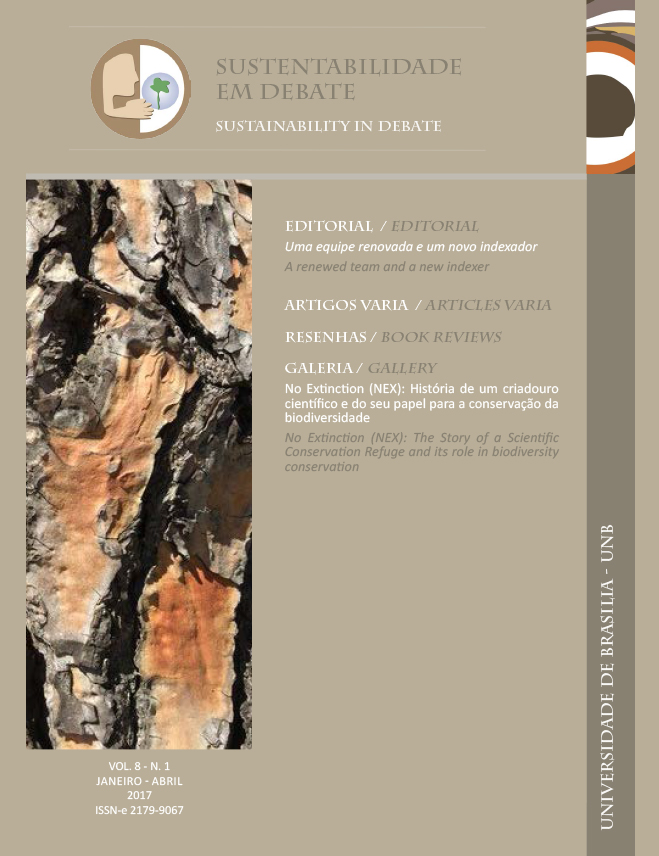The Eco-efficiency Index at the international level:
a comparative analysis of the performance of 51 countries between 1991 and 2012
DOI:
https://doi.org/10.18472/SustDeb.v8n1.2017.21089Keywords:
Ecoeficiência, Recursos Naturais, Desenvolvimento, PreservaçãoAbstract
The objective of this research was to calculate the Eco-efficiency Index (IE) for 51 countries using the Data Envelopment Analysis (DEA) method. It was found that the value of the average eco-efficiency has decreased between the years 1991 and 2012. Developed countries in general, and the European continent in particular, displayed the highest levels of eco-efficiency. Overall, in all years, the EI has been very low in most countries, half of which are developing countries and are located predominantly in the Asian continente. The main implication of this research is that stricter environmental regulations are required, especially for countries that have low eco-efficiency values. This analysis aims to incresase awareness in order to propose more sustainable developement strategies for future generations.
Downloads
References
ALEXANDER, S. A Critique of Techno-Optimism: efficiency without sufficiency is lost. Melbourne Sustainable Society Institute, Working Paper, 2014.
ALVES, J. E. D. Pegada Ecológica no mundo, Canadá e Índia, o que fazer? EcoDebate, 2016. Disponível em: <https://www.ecodebate.com.br/2016/07/29/pegada-ecologica-no-mundo-canada-e-india-o-que-fazer-artigo-de-jose-eustaquio-diniz-alves/>. Acesso em: fev. 2017.
ALVES, J. E. D. Duas enormes pegadas ecológicas: EUA grande consumo e China grande população. EcoDebate, 2014. Disponível em: <https://www.ecodebate.com.br/2014/05/07/duas-enormes-pegadas-ecologicas-eua-grande-consumo-e-china-grande-populacao-artigo-de-jose-eustaquio-diniz-alves/>. Acesso em: fev. 2017.
BANCO MUNDIAL. Dados ambientais, econômicos e sociais. 2016. Disponível em: <http://www.worldbank.org>. Acesso em: jul. 2016.
BECKERMAN, W. Economic Growth and the Environment: Whose Growth? Whose Environment. World Development, v. 20, p. 481-496, 1992.
BRASIL. Ministério do Meio Ambiente (MMA). Uso de Energias Renováveis. 2015. Disponível em: <http://www.mma.gov.br/agenda21>. Acesso em: jun. 2016.
BRAUNGAST, M.; MCDONOUGH, W.; BOLLINGER, A. Cradle ”“ to ”“ cradle design: creating healthy emissions e a strategy for eco-effective product and system design. Journal of Cleaner Production, 2006.
CAMARERO, M. et al. Eco-efficiency and convergence in OECD countries. Environ Resource Econ, 2012, p. 87-106.
CARVALHO, T. S.; ALMEIDA, E. A Hipótese da Curva de Kuznets Ambiental Global: uma perspectiva econométrico-espacial. Estudos Econômicos, São Paulo, v. 40, n. 3, p. 587-615, 2010.
COOPER, W. W.; SEIFORD, L. M.; TONE, K. Introduction to data envelopment analysis and its uses: with DEA-Solver software and references. New York: Springer, 2000. INSB-13: 978-0387-28580-1.
COOPER, W.; SEIFORD, L. M.; ZHU, J. Handbook on Data Envelopment Analysis. International Series in Operations Research & Management Science. Springer, 2004.
COOPER, J.; HERON, T.; HEWARD, W. Applied Behavior Analysis. 2nd ed. Upper Saddle River, NJ: Prentice Hall, 2007.
DEACON, R. T.; NORMAN, C. S. Is the Environmental Kuznets Curve an Empirical Regularity? UCSB Working Paper 22-03, Department of Economics, University of California, Santa Barbara, 2004.
DEPARTAMENTO DE AGRICULTURA DOS ESTADOS UNIDOS (USDA). Fatos e tendências históricas das florestas dos Estados Unidos. Washington, 2015, 64p. Disponível em: <https://www.fs.fed.us/sites/default/files/legacy_files/media/types/publication/field_pdf/508_ForestFacts_Portuguese_4_30_15.pdf>. Acesso em: nov. 2016.
GONÇALVES, J. C. Homem Natureza: uma relação conflitante ao longo da história. Revista Multidisciplinar da Uniesp, p. 7, 2007. Disponível em: <http://www.uniesp.edu.br/revista/revista6/pdf/17.pdf>. Acesso em: jan. 2015.
GREEN ENERGY LEADERS. Uruguai e as energias renováveis. 2015. Disponível em: <https://conexaoplaneta.com.br/blog/como-o-uruguai-conseguiu-ter-95-de-sua-eletricidade-gerada-por-fontes-renovaveis/>. Acesso em: fev. 2017.
GUTIÉRREZ, B.; DIAZ, A.; LOZANO, S. Eco-efficiency of eletric and eletronic appliances: a data envelopment analysis (DEA). Environmental Modeling and Assessment, 2008, p. 439-447.
HAYNES, K. E. et al. Environmental decision models: U.S. experience and a new approach to pollution management. Environment International, 1993, p. 75-261.
INTERNATIONAL ENERGY AGENCY (IEA). World energy outlook 2011. Paris: OECD/IEA, 2011. 666 p.
LEHNI, M. Eco-efficiency: creating more value with less impact. Switzerland: WBCSD, 2000.
LOMBORG, B. The Skeptical Environmentalist. Cambridge: Cambridge University Press, 2001.
MACEDO, M. A. S; BENGIO, M. C. Avaliação de eficiência organizacional através de análise envoltória de dados. In: VIII CONGRESSO INTERNACIONAL DE CUSTOS, Punta del Leste, 2003.
MANDAL, K. S.; MADHESWARAN, S. Environmental efficiency of the Indian cement industry: an interstate analysis, Energy Policy, v. 38, p. 1108-1118, 2010.
MEZA, L. A. et al. Free software for decision analysis: a software package for data enevelopment models. In: 7TH INTERNATIONAL CONFERENCE ON ENTERPRISE INFORMATION SYSTEMS ”“ ICEIS 2005, v. 2, p. 207-212.
ORGANIZAÇÃO DAS NAÇÕES UNIDAS (ONU). A cobertura florestal na China. 2016. Disponível em: <http://www.fao.org/brasil/pt/>. Acesso em: nov. 2016.
ORGANIZAÇÃO DAS NAÇÕES UNIDAS PARA AGRICULTURA E ALIMENTAÇÃO. As florestas ainda cobrem 31% da superfície da Terra. 2015. Disponível em: <http://www.fao.org/brasil/pt/>. Acesso em: set. 2016.
ORGANIZATION FOR ECONOMIC CO-OPERATION AND DEVELOPMENT (OCDE). Relatório Anual de 2003. Disponível em: <https://www.oecd.org/about/2506789.pdf>. Acesso em: jul. 2016.
PICAZO-TADEO, A. J.; GÓMEZ, J. A.; MARTINEZ, E. R. Eco-efficiency assessment of olive farms in Andalusia. Land Use Policy, v. 29, 2. ed., p. 395-406, 2012.
PROGRAMA DAS NAÇÕES UNIDAS PARA O DESENVOLVIMENTO. Desenvolvimento Humano e IDH. 2006. Disponível em: <http://www.pnud.org.br/idh/>. Acesso em: jul. 2016.
REVISTA EXAME. Os países que mais empregam em energia renovável: China é o 1º. 2015. Disponível em: <http://exame.abril.com.br/economia/os-paises-que-mais-empregam-em-energia-renovavel/>. Acesso em: out. 2016.
REVISTA EXAME. Os 10 países com o sistema elétrico mais sustentável em 2015. Disponível em: <http://exame.abril.com.br/economia/os-10-paises-com-o-sistema-eletrico-mais-sustentavel-em-2015/>. Acesso em: fev. 2017.
REVISTA EXAME. O mercado de energia renovável está radiante nos EUA. 2015. Disponível em: <http://exame.abril.com.br/economia/o-mercado-de-energia-renovavel-esta-radiante-nos-eua/>. Acesso em: nov. 2016.
ROBAINA-ALVES, M.; MOUTINHO, V.; MACEDO, P. A new frontier approach to model the eco-efficiency in European countries. Journal of Cleaner Production xxx, p. 12, 2015.
SARKIS, J. Ecoefficiency Measurement Using Data Envelopment Analysis: research and practitioner issues. Journal of Environmental Assessment Policy and Management, v. 6, n. 1, p. 91-123, 2004.
SCHALTEGGER, S. et al. Environmental Management Accounting for Cleaner Production. Eco-efficiency in Industry an Science, v. 24. Netherlands: Springer, 2008.
SHIM, H. S.; EO, S. Y. An analysis of eco-efficiency in Korean fóssil-fueled power plants using DEA. Zero-Carbon Energy Kyoto 2009: proceedings of the first international, p. 85-89, 2009.
SOARES, A. P.; SCARPA, F. Pegada ecológica: qual é a sua? São José dos Campos, SP, Inpe, 2012, 24p.
THE GUARDIAN. As emissões de gases do efeito estufa e o setor agropecuário. 2016. Disponível em: <https://www.theguardian.com/international>. Acesso em: set. 2016.
TYNKKYNEN, N.; AALTO, P. Environmental sustainability of Rusia’s energy policy. In: AALTO, P. (Org.). Russia’s energy policy: national, interregional and global levels. Cheltenham: Edward Elgar, 2012. 272p.
ÜSTUN, A. K. Evaluating environmental efficiency of Turkish cities by data envelopment analysis. Global NEST Journal, v. 17, n. 2, p. 281-290, 2015.
VERISSIMO, A.; NUSSBAUM, R. Um resumo do status das florestas em países selecionados ”“ nota técnica. The Proforest Initiative. Iamzon. 2011, 36p. Disponível em: <http://www.greenpeace.org/brasil/PageFiles/352953/academico3_portugues_baixa.pdf>. Acesso em: fev. 2017.
WORLD BUSINESS COUNCIL FOR SUSTAINABLE DEVELOPMENT ”“ WBCSD. A eco-eficiência: criar mais valor com menos impacto. Lisboa: WBCSD, 1992.
ZHANG, B. et al. Eco-efficiency analysis of industrial system in China: a data envelopment analysis a pproach. Ecological Economics, p. 306-316, 2008.
ZHANG, K. et al. Implementing stricter environmental regulation to enhance eco-efficiency and sustainability: a case study of Shandong Province’s pulp and paper industry China. Journal of Cleaner Production, n. 19, p. 303-310, 2011.
Downloads
Published
How to Cite
Issue
Section
License
SUSTAINABILITY IN DEBATE – Copyright Statement
The submission of original scientific work(s) by the authors, as the copyright holders of the text(s) sent to the journal, under the terms of Law 9.610/98, implies in the concession of copyrights of printed and/or digital publication to the Sustainability in Debate Journal of the article(s) approved for publication purposes, in a single issue of the journal. Furthermore, approved scientific work(s) will be released without any charge, or any kind of copyright reimbursement, through the journal’s website, for reading, printing and/or downloading of the text file, from the date of acceptance for publication purposes. Therefore, the authors, when submitting the article (s) to the journal, and gratuitous assignment of copyrights related to the submitted scientific work, are fully aware that they will not be remunerated for the publication of the article(s) in the journal.
The Sustainability in Debate Journal is licensed under Creative Commons License – Non-Commercial-No-Derivation Attribution (Derivative Work Ban) 3.0 Brazil, aiming at dissemination of scientific knowledge, as indicated on the journal's website, which allows the text to be shared, and be recognized in regards to its authorship and original publication in this journal.
Authors are allowed to sign additional contracts separately, for non-exclusive distribution of the works published in the Sustainability in Debate Journal (for example, in a book chapter), provided that it is expressed the texts were originally published in this journal. Authors are allowed and encouraged to publish and distribute their text online, following publication in Sustainability in Debate (e.g. in institutional repositories or their personal pages). The authors expressly agree to the terms of this Copyright Statement, which will be applied following the submission and publishing by this journal.






